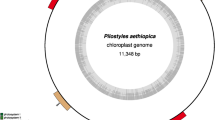Abstract
In the course of our studies on transfer RNA involvement in chlorophyll biosynthesis1, we have determined the structure of chloroplast glutamate tRNA species. Barley chloroplasts contain in addition to a tRNAGlu species at least two other glutamate-accepting tRNAGlus. We now show that the sequences of these tRNAs differ significantly: they are differentially modified forms of tRNAGln (as judged by their UUG anticodon). These mischarged Glu-tRNAGln species can be converted in crude chloroplast extracts to Gln-tRNAGln. This reaction requires a specific amidotransferase and glutamine or asparagine as amide donors. Aminoacylation studies show that chloroplasts, plant and animal mitochondria, as well as cyanobacteria, lack any detectable glutaminyl-tRNA syn-thetase activity. Therefore, the requirement for glutamine in protein synthesis in these cells and organelles is provided by the conversion of glutamate attached to an 'incorrectly' charged tRNA. A similar situation has been described for several species of Gram-positive bacteria2. Thus, it appears that the occurrence of this pathway of Gln-tRNAGln formation is widespread among organisms and is a function conserved during evolution. These findings raise questions about the origin of organelles and about the evolution of the mechanisms maintaining accuracy in protein biosynthesis.
This is a preview of subscription content, access via your institution
Access options
Subscribe to this journal
Receive 51 print issues and online access
$199.00 per year
only $3.90 per issue
Buy this article
- Purchase on Springer Link
- Instant access to full article PDF
Prices may be subject to local taxes which are calculated during checkout
Similar content being viewed by others
References
Schön, A. et al. Nature 322, 281–284 (1986).
Wilcox, M. & Nirenberg, M. Proc. natn. Acad. Sci. U.S.A. 61, 229–236 (1968).
Sprinzl, M., Hartmann, T., Meissner, F., Moll, J. & Vorderwülbecke, T. Nucleic Acids Res. 15, r53–rl88 (1987).
Ohyama, K. et al. Nature 322, 572–574 (1986).
Wilcox, M. Eur. J. Biochem. 11, 405–412 (1969).
Lapointe, J., Duplain, L. & Proulx, M. J. Bact. 165, 88–93 (1986).
Burkard, G., Guillemaut, P. & Weil, J. H. Biochim. biophys. Acta 224, 184–198 (1970).
Mubumbila, M. et al. Biochim. biophys. Acta 609, 31–39 (1980).
Louie, A., Ribeiro, S., Reid, B. R. & Jurnak, F. J. biol. Chem. 259, 5010–5016 (1984).
Srivastava, D. K. & Bernhard, S. A. Science 234, 1081–1086 (1986).
Grumont, R., Washtien, W. L., Caput, D. & Santi, D. Proc. natn. Acad. Sci. U.S.A. 83, 5387–5391 (1986).
White, B. N. & Bayley, S. T. Can. J. Biochem. 50, 601–609 (1971).
Gupta, R. J. biol. Chem. 259, 9461–9471 (1985).
Martin, N. C., Rabinowitz, M. & Fukuhara, H. J. molec. Biol. 101, 285–296 (1976).
Yang, D., Oyaizu, Y., Oyaizu, H., Olsen, G. J. & Woese, C. R. Proc. natn. Acad. Sci. U.S.A. 82, 4443–4447 (1985).
Woese, C. R. Microbiol. Rev. 61, 221–227 (1987).
Gray, M. W., Sankoff, D. & Cedergren, R. J. Nucleic Acids Res. 12, 5837–5852 (1984).
Kannangara, C. G., Gough, S. P., Oliver, R. P. & Rasmussen, S. K. Carlsberg Res. Commun. 49, 417–437 (1984).
Krupp, G. & Gross, H. J. in The Modified Nucleosides in Transfer RNA II: A Laboratory Manual of Genetic Analysis, Identification and Sequence Determination (eds Agris, P. F. & Kopper, R. A.) 11–58 (Liss, New York, 1983).
Peattie, D. Proc. natn. Acad. Sci. U.S.A. 76, 1760–1764 (1979).
Stanley, J. & Vassilenko, S. Nature 274, 87–89 (1978).
Nishimura, S. in Transfer RNA: Structure, Properties and Recognition. (eds Schimmel, P., Söll, D. & Abelson, J. N.) 551–552 (Cold Spring Harbor Laboratory, Cold Spring Harbor, New York, 1979).
von Arx, E. & Neher, R. J. Chromatogr. 12, 329–341 (1963).
Höinghaus, R. & Feierabend, J. Protoplasma 118, 114–120 (1983).
Jackson, D., Dench, J. E., Hall, D. O. & Moore, A. L. Pl. Physiol. 64, 150–153 (1979).
Ledwith, B. J., Manam, S. & Van Tuyle, G. C. J. biol. Chem. 261, 6571–6577 (1986).
Roe, B. A. Nucleic Acids Res. 2, 21–42 (1975).
Author information
Authors and Affiliations
Rights and permissions
About this article
Cite this article
Schön, A., Kannangara, C., Cough, S. et al. Protein biosynthesis in organelles requires misaminoacylation of tRNA. Nature 331, 187–190 (1988). https://doi.org/10.1038/331187a0
Received:
Accepted:
Published:
Issue Date:
DOI: https://doi.org/10.1038/331187a0
This article is cited by
-
Lethal albinic seedling, encoding a threonyl-tRNA synthetase, is involved in development of plastid protein synthesis system in rice
Plant Cell Reports (2017)
-
Gene rearrangements in gekkonid mitochondrial genomes with shuffling, loss, and reassignment of tRNA genes
BMC Genomics (2014)
-
A genomic glimpse of aminoacyl-tRNA synthetases in malaria parasite Plasmodium falciparum
BMC Genomics (2009)
-
Chlorophyll biosynthesis in higher plants. Regulatory aspects of 5-aminolevulinate formation
Journal of Plant Biology (2003)
Comments
By submitting a comment you agree to abide by our Terms and Community Guidelines. If you find something abusive or that does not comply with our terms or guidelines please flag it as inappropriate.



